
Castle Howard is a stately home in North Yorkshire, England, within the civil parish of Henderskelfe, located 15 miles (24 km) north of York. It is a private residence and has been the home of the Carlisle branch of the Howard family for more than 300 years. Castle Howard is not a fortified structure, but the term "castle" is sometimes used in the name of an English country house that was built on the site of a former castle.

Lyme Park is a large estate south of Disley, Cheshire, England, managed by the National Trust and consisting of a mansion house surrounded by formal gardens and a deer park in the Peak District National Park. The house is the largest in Cheshire, and is recorded in the National Heritage List for England as a designated Grade I listed building.
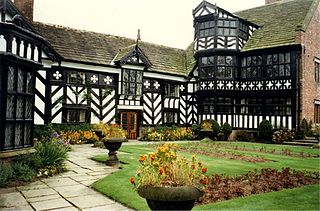
Gawsworth Old Hall is a Grade I listed country house in the village of Gawsworth, Cheshire, England. It is a timber-framed house in the Cheshire black-and-white style. The present house was built between 1480 and 1600, replacing an earlier Norman house. It was probably built as a courtyard house enclosing a quadrangle, but much of it has been demolished, leaving the house with a U-shaped plan. The present hall was owned originally by the Fitton family, and later by the Gerards, and then the Stanhopes. Since the 1930s it has been in the possession of the Richards family. Raymond Richards collected a number of items from other historic buildings and incorporated them into the hall.

Eaton Hall is the country house of the Duke of Westminster. It is 1 mile (2 km) south of the village of Eccleston, in Cheshire, England. The house is surrounded by its own formal gardens, parkland, farmland and woodland. The estate covers about 10,872 acres (4,400 ha).

Capesthorne Hall is a country house near the village of Siddington, Cheshire, England. The house and its private chapel were built in the early 18th century, replacing an earlier hall and chapel nearby. They were built to Neoclassical designs by William Smith and (probably) his son Francis. Later in the 18th century, the house was extended by the addition of an orangery and a drawing room. In the 1830s the house was remodelled by Edward Blore; the work included the addition of an extension and a frontage in Jacobean style, and joining the central block to the service wings. In about 1837 the orangery was replaced by a large conservatory designed by Joseph Paxton. In 1861 the main part of the house was virtually destroyed by fire. It was rebuilt by Anthony Salvin, who generally followed Blore's designs but made modifications to the front, rebuilt the back of the house in Jacobean style, and altered the interior. There were further alterations later in the 19th century, including remodelling of the Saloon. During the Second World War the hall was used by the Red Cross, but subsequent deterioration prompted a restoration.

Carr Manor is a Victorian grade II listed house in Meanwood, Leeds, England, designed by Edward Schroeder Prior and built for Thomas Clifford Allbutt (1836–1925). In 1881 it replaced Carr Manor House, though retaining the 1796 stable block. The former gardener's and housekeeper's cottages, the former stables and the wall, gate piers and gates are also grade II listed.

Park Crescent is a mid-19th-century residential development in the Round Hill area of Brighton, part of the English city of Brighton and Hove. The horseshoe-shaped, three-part terrace of 48 houses was designed and built by one of Brighton's most important architects, Amon Henry Wilds; by the time work started in 1849 he had 35 years' experience in the town. Wilds used the Italianate style rather than his more common Regency motifs. Three houses were replaced after the Second World War because of bomb damage, and another was the scene of one of Brighton's notorious "trunk murders" of the 1930s. The three parts of the terrace, which encircle a private garden formerly a pleasure ground and cricket pitch, have been listed at Grade II* by English Heritage for their architectural and historical importance.

Buntingsdale Hall is a historic country house in the parish of Sutton upon Tern, to the southwest of Market Drayton in Shropshire, England. It became a Grade II* listed building on 14 February 1979.

Wandesford House is an eighteenth-century almshouse in the centre of York, England, one of twelve still-functioning almshouses in the city, and the oldest still in its original building. Built in 1739 and opened in 1743, the house is an important example of the classical style in the city. Like many historic almshouses, it was referred to as a hospital before that term became chiefly associated with medical establishments.

Micklegate is a street in the City of York, England. The name means "Great Street", "gate" coming from the Old Norse gata, or street.

Bedern is a street in the city centre of York, in England, which originated as a college for the vicars choral of York Minster.
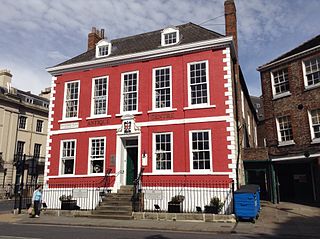
The Red House is a grade II* listed building in the city centre of York, in England.

Minster Yard is a street in the city centre of York, England. It runs along the southern, eastern and northeastern sides of York Minster, for which it is named.

Precentor's Court is an historic street in the English city of York. Although certainly in existence by 1313, the street does not appear on a map until 1610, and it is not given a name until 1722. It was given its current name exactly a century later.
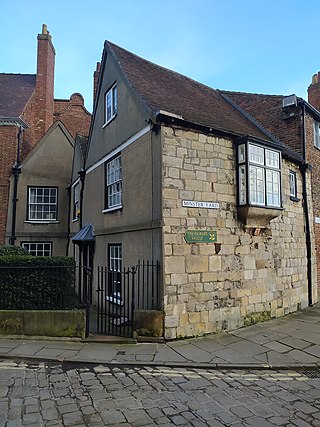
5 Minster Yard is a Grade II* listed building in the city of York, North Yorkshire, England.

Minster Gates is a north–south running street in the city centre of York, England, connecting Minster Yard and High Petergate. All of its buildings are listed, many dating to the 18th century, although the street is significantly older.
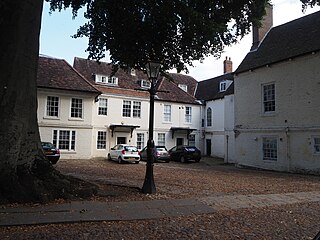
Minster Court is a Grade II* listed group of buildings lying off Minster Yard, in the city centre of York in England.
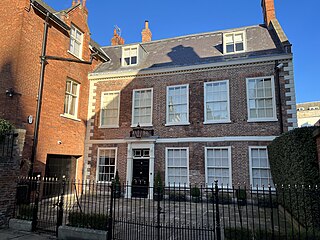
10 Precentor's Court is an historic building in the English city of York, North Yorkshire.
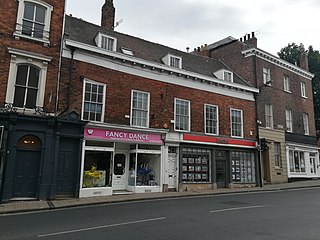
33–37 Micklegate is a historic building in the city centre of York, in England.
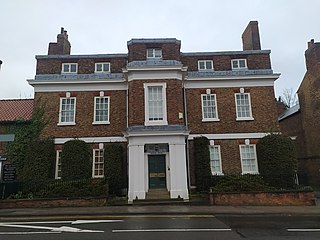
Acomb House is a historic building in the Acomb suburb of York, in England.






















